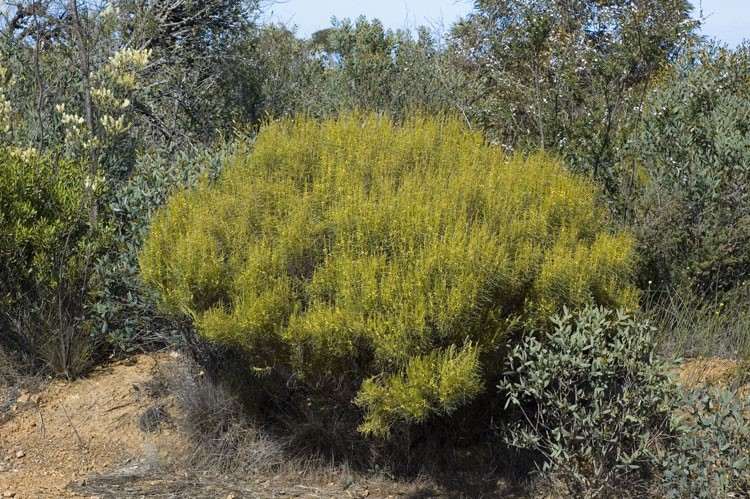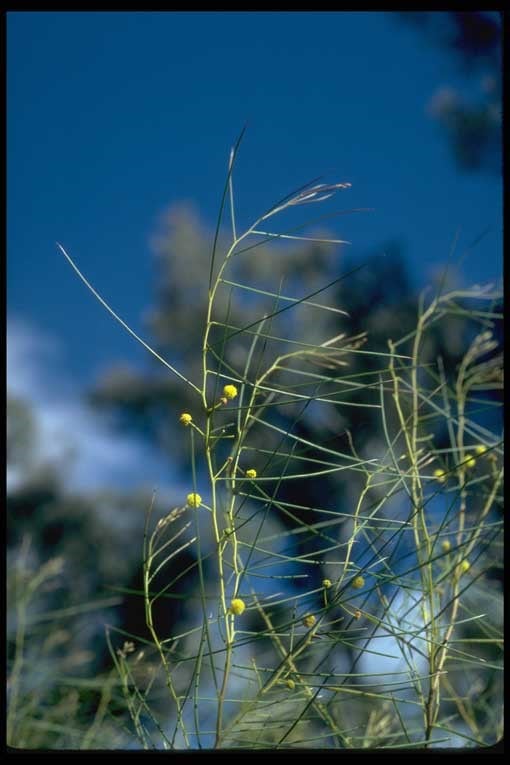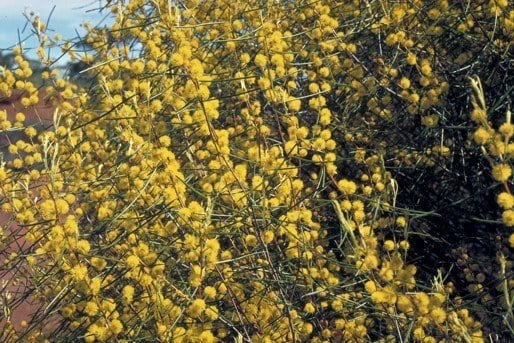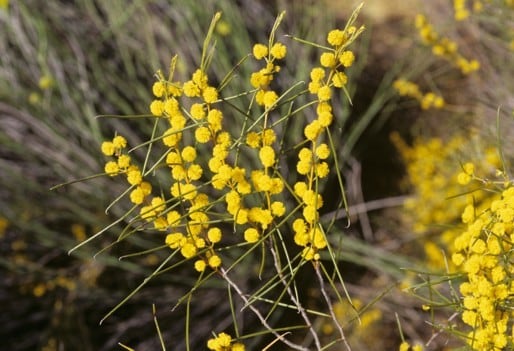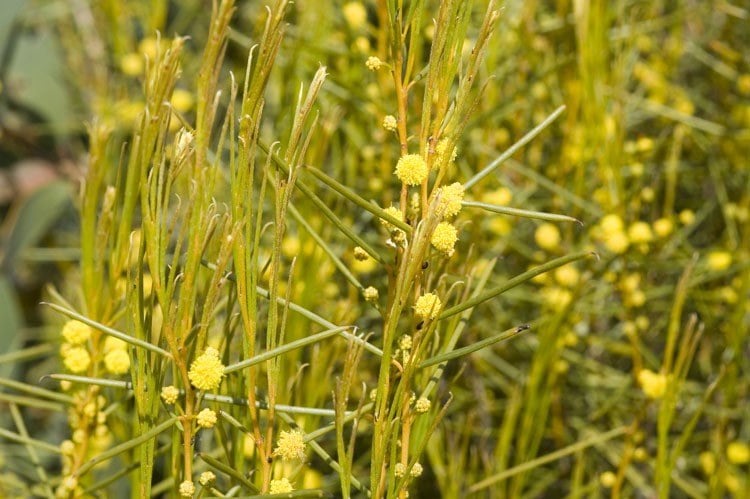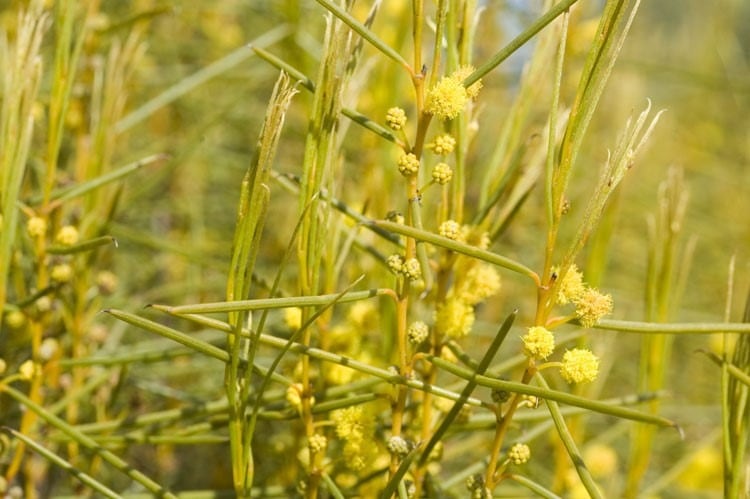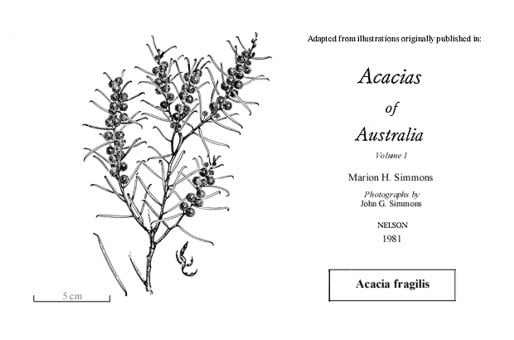Acacia fragilis Maiden & Blakely
WATTLE
Acacias of Australia
Family
Fabaceae
Distribution
Common from near Carnamah SSE to the Cunderdin–Merredin area in south-western W.A. Outlying populations occur near Holt Rock (c. 170 km SE of Merredin), near Boondi (c. 190 km E of Merredin) and on Ponton Ck, 20.5 km E of Zanthus (c. 600 km E of Merredin). Additionally, a variant from near Grasspatch (N of Esperance) and the Ravensthorpe Ra. is noted below.
Description
Dense rounded shrub 0.5–2.5 m high. New shoots golden-sericeous. Branchlets terete, glabrous. Phyllodes reclined to erect, straight to shallowly curved, terete to subterete, 3.5–7 (-8) cm long, (0.5–) 1–1.3 mm diam., arcuate-acuminate to caudate-acuminate with a slender 1.5-7 mm long, puberulous or appressed-puberulous at first, ±glabrescent, rarely glabrous tip, glabrous (except usually tip), with 8 nerves but sometimes appearing more when dry because of longitudinal wrinkling; nerves raised, distant; gland to 0.5 mm long, not always evident, (2–) 7–14 mm above pulvinus; pulvinus 1.5–3 mm long, cylindrical. Inflorescences simple, 2 per axil; peduncles 4–5.5 (–8) mm long, ±appressed-puberulous or glabrous; heads globular, 4–4.5 mm diam., (12–) 23–31-flowered, golden. Flowers 5-merous; sepals free; petals usually free. Pods linear, raised on alternating sides over and slightly constricted between seeds, 5–7 cm long, 2–3 (–4.5) mm wide, thin-crustaceous, shiny, glabrous. Seeds longitudinal, elliptic, 2.5–3 mm long, dull, brown; aril subterminal.
Habitat
Grows in sand, gravelly or clayey sand and rocky or sandy loam in heath and on sandplains with mallee eucalypts and wattles.
Specimens
W.A.: Ravensthorpe Ra., E.M.Bennett 2340 (CANB, K, MEL, NY, PERTH); c. 3 km by road SE of Kondut on road to Cadoux, L.Haegi 1109 (NSW, PERTH); 6 km S of Tammin, B.R.Maslin 2319 (BRI, K, PERTH); 1.6 km from Wubin towards Mount Magnet, B.R.Maslin 3529 (CANB, MEL, NY, PERTH); Ponton Ck, 20.5 km E of Zanthus, J.Taylor 552 et al. (CANB, PERTH).
Notes
Acacia fragilis is a highly variable species distinguished somewhat arbitrarily from its closest relative, A. uncinella; see R.S.Cowan & B.R.Maslin, Nuytsia 10: 237–249 (1995), for discussion. All characters vary to some extent but, in general, A. fragilis is recognised by its longer phyllodes the apices of which terminate in a long to very long, gently curved, pubescent tip; the pubescence on the tip varies from appressed to spreading, is always present on juvenile phyllodes and usually persists on at least some of the mature ones. Union of the petals in A. uncinella which, in part, distinguishes it from A. fragilis, appears sporadically without any obvious pattern in A. fragilis as well. There is also some evidence of hybridisation between the two species in the area where their ranges overlap.
Acacia fragilis together with A. assimilis, A. aulacophylla, A. consanguinea, A. ophiolithica and A. uncinella constitutes the ‘A. fragilis group’; see R.S.Cowan & B.R.Maslin, Nuytsia 10: 237–249 (1995), for further notes.
Specimens from the Ravensthorpe Ra. and near Grasspatch are attributed to A. fragilis largely on the basis of their phyllode length but they occur within the range of A. uncinella and share characters of both species. The single Zanthus collection has narrow phyllodes and long peduncles. Resolution of this complex is clearly still to be sought.
FOA Reference
Data derived from Flora of Australia Volumes 11A (2001), 11B (2001) and 12 (1998), products of ABRS, ©Commonwealth of Australia
Author
Minor edits by J.Reid
R.S.Cowan
This identification key and fact sheets are available as a mobile application:
URL: https://apps.lucidcentral.org/wattle/
© Copyright 2018. All rights reserved.

